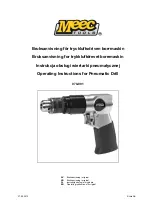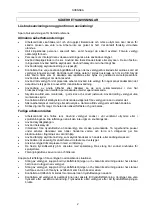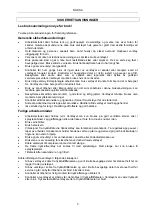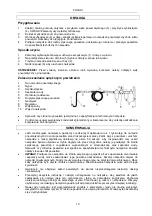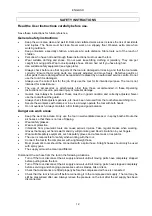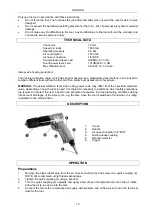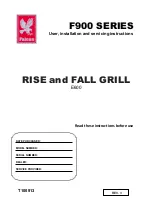
ENGLISH
12
ENGLISH
SAFETY INSTRUCTIONS
Read the User Instructions carefully before use.
Save these instructions for future reference.
General safety instructions
Keep the work area clean and well lit. Dark and cluttered work areas increase the risk of accidents
and injuries. The floors must be clean. Never work on a slippery floor. Observe extra care when
working outdoors.
Keep onlookers, especially children, and pets at a safe distance. Store tools out of the reach of
children.
Persons who have not read through these instructions must not use the tool.
Wear suitable clothing and shoes. Do not wear loose-fitting clothing or jewellery. They can get
caught in moving parts. Wear non-slip safety shoes. Wear a hair net if you have long hair.
Use suitable safety equipment (see type plate).
Always check before use that no parts of the tool are damaged or missing, and that the tool works
correctly. Ensure that moving parts are properly adjusted and move freely. Defective guards or
other parts that are damaged must be repaired or replaced by an authorised service centre. Do not
use the tool if it is damaged.
Always use the correct tool for the job. Only use the tool for its intended purpose. The tool is not
intended for industrial use.
The use of accessories or attachments other than those recommended in these Operating
Instructions can result in personal injury or material damage.
Guards must always be installed. These must be in good condition and correctly adjusted. Never
use the tool without the guard.
Always check that adjuster spanners, etc. have been removed from the tool before switching it on.
Secure the workpiece with clamps or in a vice. Always operate the tool with both hands.
Do not overreach. Always maintain a firm footing and good balance.
Dangerous work areas
Keep the work area clean. Only use the tool in well ventilated areas or in spray booths. Route the
air hoses so that there is no risk of tripping.
Wear safety glasses.
Wear ear protection.
Vibrations from pneumatic tools can cause serious injuries. Take regular breaks when working.
Gloves that keep your hands warm and dry will promote good blood circulation in your fingers.
Wear suitable safety equipment, such as safety gloves and a face mask or respirator.
The user is responsible for safety when working with the tool.
Connect the tool to the compressor with a lightweight hose.
Most pneumatic tools should be connected with a spiral hose. Straight hoses should only be used
with spray guns.
The supply air must be clean and filtered.
Disconnect the air hose from the tool in the following situations.
Turn off the tool, disconnect the air supply and wait until all moving parts have completely stopped
before putting down the tool.
Turn off the tool, disconnect the air supply and wait until all moving parts have stopped completely
before servicing and changing accessories such as blades, bits or discs.
Check that accessories are fitted properly before the compressed air hose is connected.
Check that the tool is turned off before connecting it to the compressed air supply. The tool may be
still be pressurised after use. Always relieve the pressure on the tool after the air supply has been
disconnected.
Summary of Contents for 070-001
Page 15: ......

